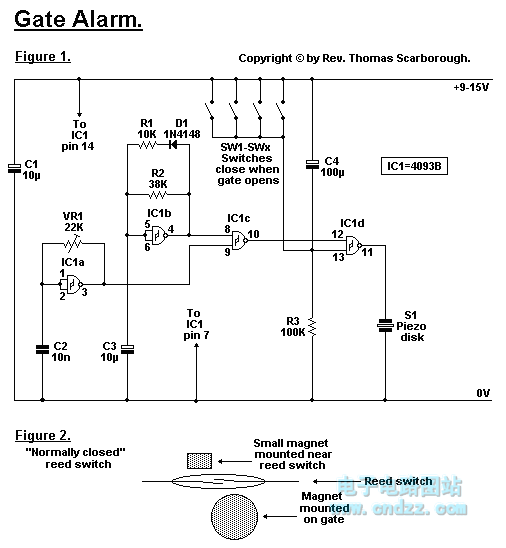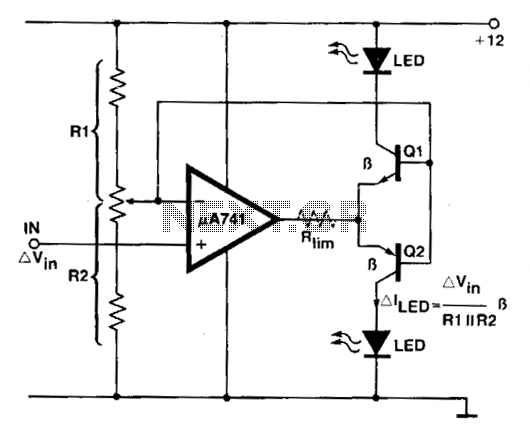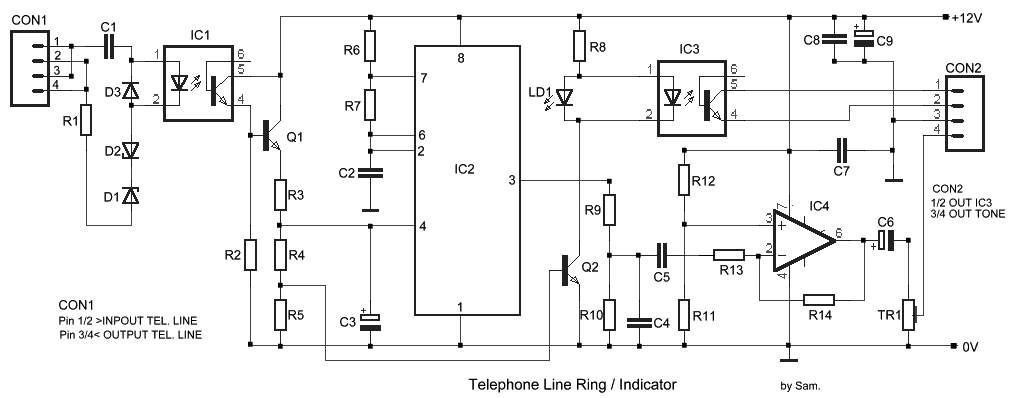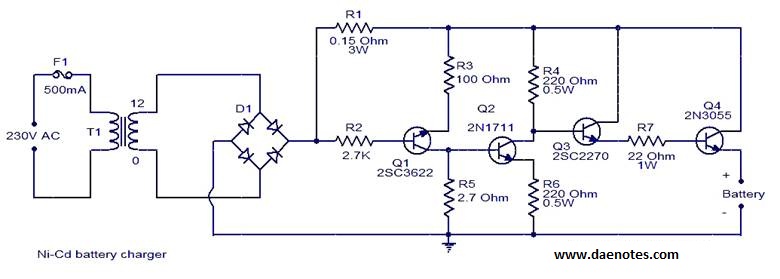
The door bell circuit

Figure 1 illustrates an economical and straightforward Gate Alarm designed to operate using a small universal AC-DC power supply. IC1a functions as a fast oscillator, while IC1b serves as a slow oscillator. These two oscillators are integrated through IC1c to produce a high-pitched warning sound, indicated as a series of 'pip-pip-pip' tones, triggered when a gate or window is opened. The circuit is not specifically intended to mimic the sound of a siren or traditional warning device.
The Gate Alarm circuit employs a combination of oscillators to generate distinct audio alerts, enhancing security by providing immediate auditory feedback upon unauthorized access. IC1a, the fast oscillator, is likely configured to operate at a higher frequency, producing rapid pulses. This rapid oscillation is crucial for creating a sharp and attention-grabbing sound. In contrast, IC1b, the slow oscillator, operates at a lower frequency, contributing a more subdued tone that complements the fast oscillator's output.
The integration of IC1c is essential for combining the outputs of both oscillators. This integrated circuit may serve as a mixer or a comparator, ensuring that the signals from IC1a and IC1b are appropriately combined to produce a coherent audio output. The resulting sound pattern is designed to be easily recognizable, alerting individuals in proximity to the gate or window that it has been opened.
The power supply for this circuit is a universal AC-DC converter, which allows for versatile application in various environments. This feature makes the Gate Alarm suitable for residential use, enhancing security around homes, garages, and other entry points. The simplicity of the design ensures that it can be built with readily available components, making it an accessible project for hobbyists and professionals alike.
Overall, the Gate Alarm circuit combines functionality with simplicity, providing an effective solution for security monitoring with minimal cost and complexity. Its design principles can be applied to various applications, including home security systems and alert mechanisms in commercial settings.Figure 1 represents a cheap and simple Gate Alarm, that is intended to run off a small universal AC-DC power supply. IC1a is a fast oscillator, and IC1b a slow oscillator, which are combined through IC1c to emit a high pip-pip-pip warning sound when a gate (or window, etc.) is opened.
The circuit is intended not so much to sound like a siren or warning dev.. 🔗 External reference
The Gate Alarm circuit employs a combination of oscillators to generate distinct audio alerts, enhancing security by providing immediate auditory feedback upon unauthorized access. IC1a, the fast oscillator, is likely configured to operate at a higher frequency, producing rapid pulses. This rapid oscillation is crucial for creating a sharp and attention-grabbing sound. In contrast, IC1b, the slow oscillator, operates at a lower frequency, contributing a more subdued tone that complements the fast oscillator's output.
The integration of IC1c is essential for combining the outputs of both oscillators. This integrated circuit may serve as a mixer or a comparator, ensuring that the signals from IC1a and IC1b are appropriately combined to produce a coherent audio output. The resulting sound pattern is designed to be easily recognizable, alerting individuals in proximity to the gate or window that it has been opened.
The power supply for this circuit is a universal AC-DC converter, which allows for versatile application in various environments. This feature makes the Gate Alarm suitable for residential use, enhancing security around homes, garages, and other entry points. The simplicity of the design ensures that it can be built with readily available components, making it an accessible project for hobbyists and professionals alike.
Overall, the Gate Alarm circuit combines functionality with simplicity, providing an effective solution for security monitoring with minimal cost and complexity. Its design principles can be applied to various applications, including home security systems and alert mechanisms in commercial settings.Figure 1 represents a cheap and simple Gate Alarm, that is intended to run off a small universal AC-DC power supply. IC1a is a fast oscillator, and IC1b a slow oscillator, which are combined through IC1c to emit a high pip-pip-pip warning sound when a gate (or window, etc.) is opened.
The circuit is intended not so much to sound like a siren or warning dev.. 🔗 External reference





